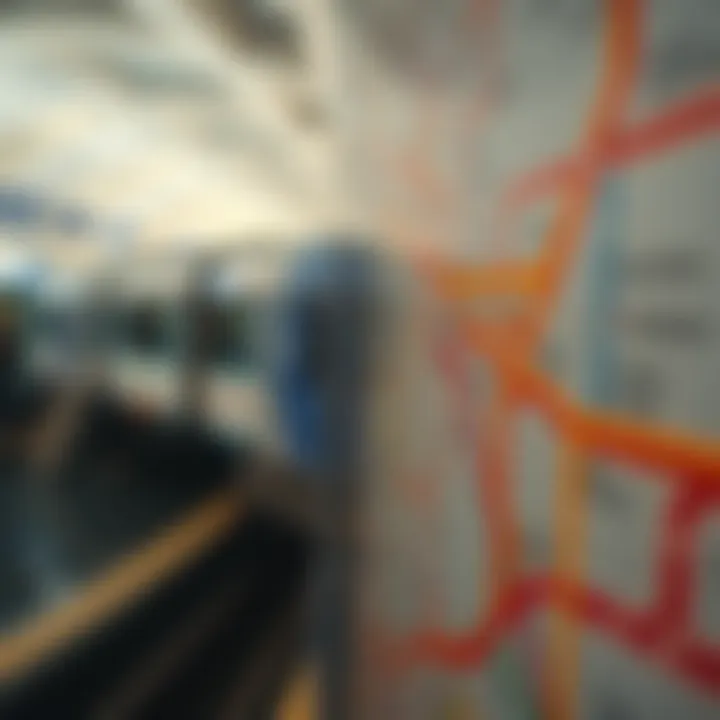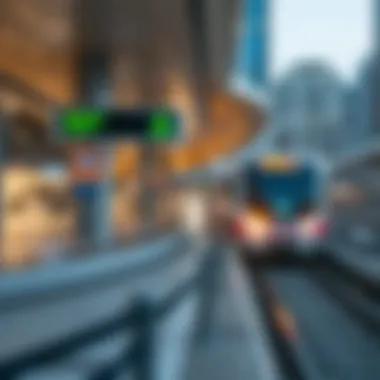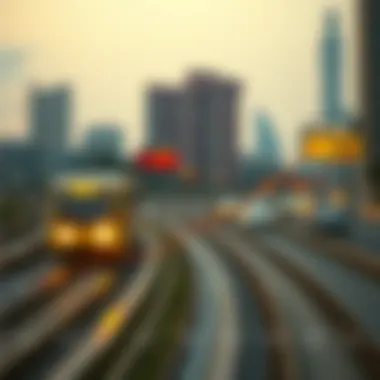Exploring the Latest Metro Map of Dubai


Intro
The Dubai Metro has transformed the way people navigate this bustling metropolis. The latest updates to the metro map reflect not just infrastructural growth but also a pivotal shift in the urban landscape. Understanding these changes is crucial for anyone involved in Dubai’s real estate market, be it investors, homeowners, or real estate professionals. The metro system serves as a circulatory system, breathing life into neighborhoods and giving rise to opportunities for investment and development.
As we delve into the recent updates to the metro map, we will explore the new lines and stations that have been introduced and discuss how these changes impact surrounding areas. The interplay between transport infrastructure and real estate dynamics cannot be understated. A well-connected neighborhood often sees a spike in property values, making it a key consideration for anyone looking to invest or settle down in Dubai. Through this comprehensive guide, we aim to equip our readers with insightful knowledge on navigating the evolving landscape influenced by the metro system.
Market Insights
As Dubai continues to grow, so does its real estate market, which is currently experiencing a fascinating evolution. This section breaks down current trends in Dubai real estate and scrutinizes economic factors affecting property prices.
Current Trends in Dubai Real Estate
In recent years, the real estate market in Dubai has shown positive signs of recovery. Interest in property has been piqued by various factors, most notably the ongoing enhancements to the metro system. New lines and stations attract both local and international buyers looking to capitalize on areas that promise better connectivity. Developers are placing a strong emphasis on projects near metro stations, a trend that has sparked a refreshing change in residential and commercial developments.
Moreover, Dubai's government has been proactive in introducing incentives for investors, such as easing visa regulations and providing competitive mortgage options. These efforts have further strengthened the interest in the market. One cannot overlook how rapidly growing sectors, like tourism and technology, have begun reshaping demand.
Economic Factors Affecting Property Prices
The interplay of several economic elements heavily influences property pricing in Dubai. Among them are:
- Oil Prices: Being a crucial element in the UAE economy, fluctuations in oil prices can impact overall market stability.
- Global Economic Climate: As a cosmopolitan hub, changes in the global economy can lead to overseas investment flowing into Dubai’s real estate market.
- Inflation Rates: Rising inflation can squeeze household budgets, affecting property demand.
- Demographic Shifts: The influx of expatriates continues to drive demand for rentals and purchasable homes.
These factors are intrinsic to understanding market dynamics. For instance, the surge in demand often leads to increased prices in well-connected areas, especially adjacent to new metro stations. Investors need to keep a keen eye on these economic indicators to make informed decisions.
Buying and Investing Tips
The landscape may seem intricate for first-time buyers and investors, but with a structured approach, one can navigate it effectively. Here, we present essential steps to consider.
Essential Steps for First-Time Buyers
If you're a newcomer to the real estate scene in Dubai, it's crucial to know what to prioritize:
- Research Thoroughly: Understand the different neighborhoods connected to the metro, their amenities, and their projected growth.
- Know Your Budget: Determine your financial capabilities upfront to avoid getting swept away in the market's excitement.
- Consult Experts: Reach out to real estate agents well-versed in metro-linked properties; their insights can be invaluable.
Financing Options and Investment Strategies
Understanding the various financing options available can ease the purchasing process. Consider exploring:
- Mortgages: Numerous local banks offer attractive mortgage rates tailored for expatriates.
- Property Investment Funds: These can be a safer bet for those apprehensive about direct ownership.
- Joint Ventures: Partnering with established local businesses can provide a trusted entry into the market.
Investing in a location adjacent to the metro could potentially yield higher returns, as connectivity typically translates to increased market appeal.
Ending
In summary, the expansion of the Dubai Metro offers more than just a means of transportation. It encapsulates a broader narrative of growth, opportunity, and strategic investment in the real estate market. By understanding the latest developments and their implications, potential buyers and investors can make informed choices that align with their goals in this vibrant city. More than a map, the metro represents a vital thread weaving through the fabric of Dubai’s urban development.
"Opportunity doesn't knock; it presents itself when you beat down the door."
For further information on Dubai’s real estate market trends, consider visiting sources such as Wikipedia, Britannica, and engaging discussions on platforms like Reddit. These resources can provide additional insights into the ever-evolving landscape of Dubai real estate.
Understanding the Dubai Metro System
The Dubai Metro, a key component of the city’s public transport tapestry, serves as more than just a means of getting from Point A to Point B. It acts as a catalyst for urban development, influencing the layout and growth patterns of Dubai's neighborhoods. Understanding the metro system is essential for various stakeholders, including investors, homeowners, agents, and urban planners. It reveals insights into connectivity, accessibility, and socio-economic dynamics that can shape decisions in real estate and urban living.
History and Evolution
The evolution of the Dubai Metro began in response to the rapid urbanization the city experienced in the late 20th century. Established in 2009, the project aimed to combat the growing traffic congestion and enhance the efficiency of public transit. The initial stretch, known as the Red Line, connected major landmarks, including the Dubai International Airport and the Burj Khalifa area, thereby catering to both residents and tourists.
Set against an ambitious backdrop, the metro system has undergone multiple phases, continuously expanding its reach. The completion of the Green Line shortly thereafter marked a significant milestone, providing further options for residents in densely populated districts. These lines don't merely connect geographical points; they link communities, shaping social interactions and economic opportunities.
In recent years, the focus has shifted toward sustainability and modernization. With the introduction of driverless trains and energy-efficient systems, the evolution of the metro reflects a commitment to smart city aspirations. This trend underscores a broader narrative: as the metro advances, so does the city’s ambition to create a feasible, eco-friendly transport solution.
Current Infrastructure Overview
As of today, the Dubai Metro features two primary lines—the Red Line and the Green Line—spanning over 90 kilometers in total. The system encompasses more than 50 stations, situating it among the most extensive and advanced metro networks in the region.
Key stations such as Union and Burj Khalifa/Dubai Mall fuse functionality with modern design, enhancing user experience. Stations are equipped with state-of-the-art technology and amenities aimed at easing commuters’ journeys. Reliable air conditioning systems and digital scheduling screens represent just a few aspects that contribute to traveler comfort.
Moreover, the network is interlinked with other transportation modes, such as buses and water taxis, creating seamless transfer points for commuters. This integrated approach not only improves travel efficiency but also strengthens the metro’s role in urban mobility.


In summary, the current infrastructure of the Dubai Metro showcases thoughtful planning and technological innovation. Understanding the layout and operational specifics of the Dubai Metro system remains essential for navigating the dynamics of real estate and urban living in this vibrant metropolis.
Analysis of the Latest Metro Map
Understanding the latest metro map is vital for several reasons. First and foremost, it offers a visual representation of the expansion and transformation of Dubai’s metro network. This landscape of interlinked lines and stations is not just a blueprint for public transport; it reflects the rhythms of urban life, economic potential, and investment opportunities. By analyzing this map and exploring its elements, one can better comprehend how connectivity influences real estate dynamics and regional growth.
Recent Additions to the Network
The recent upgrades and additions to the Dubai Metro system have significantly altered the transport landscape. The introduction of the Route 2020, which extends the Red Line to the Expo 2020 site, has transformed accessibility to major exhibitions and events. This extension has also opened new avenues for the surrounding neighborhoods, making them more attractive to residents and investors alike.
Another notable development is the Green Line's expansion, which connects vital parts of the city, such as the Al Jaddaf and Dubai Healthcare City areas. This not only eases daily commutes but also supports the growth of businesses in these regions. Key stations, like the Dubai Creek Harbour and the new link to Dubai International Airport, serve as pivotal points, enhancing both local and international accessibility. The impact of these developments resonates across multiple sectors, providing ample opportunities for real estate stakeholders.
Key Stations and Their Importance
When discussing the latest metro map, certain stations stand out as critical junctures that effectively drive urban growth. For instance, the Emirates Towers Station offers not just a gateway to the metro but a direct link to commercial giants and luxury hotels, creating a nexus for both business and leisure.
Business Bay Station holds similar significance due to its proximity to wealthy commercial hubs, attracting professionals and investors who prefer life closer to their workplaces. The Burj Khalifa/Dubai Mall Station serves as another landmark in the city, drawing tourists and residents alike, which bolsters retail and hospitality ventures in the vicinity.
As essential access points, these stations contribute to the appeal of their neighborhoods and play a crucial role in shaping the real estate market. High value properties often emerge from areas linked by the metro, further stimulating demand. The interplay between metro accessibility and property value is clear: as convenience improves, so does investment interest.
"The evolution of the Dubai Metro reflects not only infrastructure development, but also the strategic vision for a modern and connected city."
Impact on Local Real Estate Trends
The evolution of the Dubai Metro system carries significant weight in shaping the local real estate landscape. With every new line and stop added to the metro map, the dynamics of surrounding neighborhoods inevitably shift. Investors, homeowners, and real estate agents must be attuned to these changes, as they can pave the way for lucrative opportunities or determine potential pitfalls.
Correlation Between Metro Accessibility and Property Values
It’s no secret that accessibility often dictates property values. When a new metro line rolls out, the neighborhoods near those stations often see a noticeable uptick in real estate demand. This phenomenon can be attributed to several factors:
- Convenience: Easy access to metro stations is a major selling point for any property. Commutes become less cumbersome, making areas more appealing to families, professionals, and even students.
- Increased Foot Traffic: Locations near metro stations draw in more foot traffic, which can nudge up the demand for commercial spaces as well. Retail businesses thrive in high-traffic areas, making properties in these locales more attractive.
- Infrastructure Investment: The government often invests in the infrastructure around new metro stations, further enhancing the desirability of the area. This can include parks, roads, and other public amenities that raise the quality of life.
In essence, the math is simple: improved transit access often translates into rising property values. Investors keeping a keen eye on metro developments stand to benefit greatly from making educated decisions based on these correlations.
Emerging Neighborhoods Near New Metro Lines
With the rapid expansion of the Dubai Metro, new neighborhoods are cropping up as desirable spots for both living and investment. These areas tend to share certain characteristics that make them worth exploring:
- Affordability: Often, the initial launch of a new metro line leads to the development of more affordable housing options. This creates an entry point for first-time buyers and investors seeking less competitive markets.
- Urban Renewal: Areas that may have previously been overlooked are often rejuvenated by new metro lines. Old buildings are renovated, and new developments emerge, breathing life back into neighborhoods that may have needed a refresh.
- Access to Amenities: Typically, areas near new metro stops will see an influx of shops, restaurants, and recreational facilities. The synergy that develops fosters vibrant communities which attract more residents over time.
As new lines unfold on the metro map, many of these neighborhoods emerge as investors' gold mines. Keeping tabs on real estate trends in conjunction with metro developments can guide strategic investment decisions.
"The continuity of transport networks is as crucial as the pulses of a city. Where the metro stretches, opportunity flows."
Investors looking for solid returns must acknowledge and leverage the potential of these expanding neighborhoods. As Dubai continues to flourish, the interplay of metro transit and real estate will only deepen, necessitating a forward-thinking approach from those looking to be part of the action.
Travel Efficiency and Urban Mobility
The role of the Metro system in shaping travel efficiency and urban mobility in Dubai cannot be overstated. As the city continues to expand rapidly, the reliance on efficient public transit becomes crucial for both residents and visitors alike. The Metro not only alleviates congestion but also paves the way for a seamless experience when navigating through this sprawling metropolis.
One of the primary benefits of the Metro system is its high frequency of service. With trains running every few minutes, commuters can avoid the hassle of long wait times. This reliability is particularly essential during peak hours when roads are often choked with traffic. Furthermore, the Metro connects key areas of the city, enabling easy access to business districts, shopping centers, and tourist attractions. Each of these connections directly contributes to a more efficient travel experience, allowing individuals to maximize productivity while minimizing transit times.
Enhancements in Daily Commuting
Recent enhancements to the metro infrastructure have transformed daily commuting for many Dubai residents. The addition of new lines and stations makes it simpler for people to incorporate the metro into their daily routines. For instance, the Route 2020 extension, which connects the Expo 2020 site to the existing network, encourages more individuals to use public transport instead of driving. This connection not just promotes sustainability but also adds convenience, pulling more residents away from car dependency.
Moreover, the trains are equipped with modern amenities, such as Wi-Fi and comfortable seating, catering to the needs of busy professionals who may be working on the go.
"Public transport isn't just about getting from point A to point B; it's about making the journey pleasant and efficient."
With the introduction of smarter ticketing systems, commuters can now enjoy easy fare options, integrated apps for real-time updates, and simplified navigation across connected transit modes. The cumulative effect of these enhancements means that commuting no longer feels like a chore but an integral part of urban life.
Linkages to Other Transport Systems
An integral feature of Dubai’s metro system is its connectivity with other modes of transportation. This seamless integration is vital in enhancing overall travel efficiency. The city’s strategic planning has ensured that metro stations link up conveniently with buses, taxis, and even boats in some areas.
- Buses: More than 100 bus routes intersect with metro stations. This system not only extends the reach of the metro but also helps in managing passenger flow during peak hours. Buses operate on a synchronized schedule with metro arrivals, which reduces waiting times and enhances the commuting experience.
- Taxis: Designated taxi stands at metro stations facilitate quick transfers for passengers seeking direct routes without needing to navigate through traffic.
- Marine Transport: The Dubai Water Canal and Dubai Marina have ferry services that are linked to the metro stations, allowing for a scenic alternative to conventional transport methods.
The connected transport ecosystem is thoughtful in its design. The goal here is straightforward: ease of access. When travelers can switch between systems effortlessly, it empowers them to choose public transport over personal vehicles, thereby reducing traffic congestion significantly.


In summary, the enhancements in daily commuting and the linkages to other transport systems collectively underscore how the Dubai Metro is not just a transit service but a catalyst for urban mobility and travel efficiency. Its development is a testament to Dubai's forward-thinking urban planning and a crucial aspect of how the city positions itself as a global hub for both commerce and tourism.
Future Plans for Metro Expansion
The Dubai Metro, a key player in the urban landscape, is on the brink of significant expansion. This development is not only pivotal for the city's infrastructure but also critical for investors and residents alike. Understanding the future plans for the metro expansion sheds light on the dynamics of the urban environment, the potential growth areas, and the overall impacts on real estate. With an ever-increasing population and an urgent need for efficient transport systems, these expansions will shape the very fabric of Dubai.
Proposed Routes and Stations
One of the most intriguing aspects of the upcoming expansions is the proposed routes and stations. These new additions are strategically designed to connect various neighborhoods and commercial districts, enhancing accessibility for commuters.
- Route Redesigns: Planned changes in existing routes will optimize flow, ensuring that even during peak hours, travel remains efficient.
- New Stations: The introduction of stations like Al Quoz Industrial Area and Dubai South will cater to burgeoning areas where residential and commercial activities are on the rise. These locations are positioned to become the next hotspots for property investment.
- Integration: New lines aim to seamlessly integrate with existing transport systems, including the tram service and bus routes, creating a network that facilitates ease of travel for all.
This proactive planning shows a commitment to not just meet current demands but also to anticipate future needs. With each new station, the potential for economic activity increases, presenting lucrative opportunities for real estate development.
Long-Term Vision for Dubai's Public Transport
The long-term vision for Dubai’s public transport is ambitious and transformative. City planners envision the metro system as a backbone to the urban transport grid, encouraging sustainable growth and reducing congestion.
- Sustainability Goals: Emphasis on eco-friendly transport will lead to reduced carbon footprints, promoting a healthier environment. Enhancing public transit options contributes to a decrease in car dependency, aligning with global sustainability initiatives.
- City Connectivity: The goal is to create a web of transit options that not only connects suburbs to the main city but also intertwines with tourist attractions, promoting economic activity.
- Accessibility for All: Future expansions are designed with inclusivity in mind, ensuring that the metro is accessible to all demographics, including those with disabilities.
In summary, the future plan for metro expansion is not merely about constructing new lines but is a thoughtful strategy that aims to redefine urban living in Dubai.
Investors looking to capitalize on this expansion should focus on emerging neighborhoods along proposed lines, as these areas are likely to see substantial growth in property values.
By keeping a finger on the pulse of these developments, investors can make informed decisions and potentially reap significant rewards from the evolving landscape of Dubai’s real estate market.
Economic Impacts of Metro Development
The development of the Dubai Metro has a significant effect on the local economy, influencing various sectors from real estate to small businesses. This section explores these impacts, illustrating how infrastructure plays a pivotal role in not just transportation, but also economic vitality.
Investment Opportunities Linked to Metro Growth
The introduction of new metro lines and stations in Dubai creates ripe opportunities for investors. Properties located close to metro stations often see a surge in demand, thus boosting property values. Investors aiming to tap into this growth must consider several factors:
- Proximity to Metro Stations: Properties closer to metro stations generally attract higher occupancy rates and rental prices. Investors should scout locations near newly developed or proposed stations.
- Future Developments: With planned expansions of the metro network, keeping an eye on upcoming stations can guide investment decisions. Areas that are not yet fully developed might see a significant bump in growth once metro lines are established.
- Accessibility and Connectivity: Enhanced connectivity can lead to increased footfall in commercial spaces. Investors in retail properties should evaluate how easy access to metro stations can drive customer traffic.
The chances of seeing substantial return on investment in areas serviced by the metro are considerably higher, making it essential for savvy investors to remain in-the-know about the latest metro updates.
Boosting Local Businesses and Attractions
The metro system acts as a pulse for local commerce and attraction appeal. Businesses situated near metro stations often witness an increase in customers. Here’s how metro development boosts local businesses and attractions:
- Increased Foot Traffic: The convenience of accessing various locales through the metro increases foot traffic in nearby shops, cafes, and entertainment destinations. Businesses benefit as more commuters are likely to stop for a quick coffee or shopping spree after disembarking from the metro.
- Diverse Customer Base: The metro serves a wide demographic, attracting not just local residents but also tourists and expatriates. This diversity allows local businesses to cater to a broader audience, often leading to increased sales and profitability.
- Synergy with Attractions: Many of Dubai's key attractions such as shopping malls, parks, and museums are conveniently located near metro stations. This synergy means that local businesses get to capitalize on the tourism these attractions draw. For instance, a restaurant close to a popular mall could see a spike in business during weekends when families go out.
"The Dubai Metro isn't just about transportation; it’s a catalyst for economic engagement and growth, creating endless opportunities for those who are in the know."
In summary, the economic impacts of metro development in Dubai go beyond mere transportation. They encompass investment opportunities, support for local businesses, and a noticeable shift in community dynamics, making it essential for stakeholders to consider these factors in their strategic planning.
Community Perspectives on Metro Enhancements
Understanding the community’s take on the enhancements brought by the Dubai Metro system is paramount, especially considering the diverse fabric of the city. As both residents and commuters interact with the network, their experiences and insights shape the narrative around public transport. The integration of a more extensive metro map not only influences daily life but also reflects the evolving needs of an ever-growing population. Understanding these perspectives sheds light on critical aspects like accessibility, convenience, and quality of life improvements, which are vital for potential investors to consider.
Feedback from Residents and Commuters
When we gather feedback from those who use the metro on a daily basis, an array of opinions emerges. Some residents praise the accessibility of the metro system, particularly in previously under-served areas. For instance, a resident from the Al Quoz region noted, "Having a station just a stone's throw away has changed my commuting game, making it so much easier to get to work."
Conversely, there are concerns regarding overcrowding during peak hours, a common refrain among commuters. A frequent traveler might say, "While the metro is efficient, there are times it feels like a sardine can. I often struggle to find space, especially in the mornings." Such candid feedback is crucial for authorities to address potential pitfalls while expanding the metro’s reach.
Moreover, some commuters emphasize the affordability of using the metro compared to other forms of transport. Instances where suburban families can significantly cut travel costs by opting for this mode, rather than taxis or personal vehicles, highlight its economic benefits. This, in turn, can steer real estate investments toward areas near metro stations due to the perceived value added.
Impact on Lifestyle and Daily Routines
The enhancements to the Dubai Metro have undeniably transformed daily routines for many residents. With the system offering reliable access to not just the workplace but to shopping, dining, and entertainment, the metro influences lifestyle choices significantly. People living close to metro stations may find themselves more inclined to explore various neighborhoods, driving up foot traffic and bolstering local businesses as a result.
For families, the metro's expansion means less time spent in traffic and more time for leisure activities. The ability to hop on and off conveniently encourages social outings, such as meeting friends for dinner or attending cultural events.
Additionally, as the metro enhances connectivity, individuals become less dependent on cars, contributing to a slight shift towards a more environmentally conscious lifestyle. Reduced vehicular traffic can lead to better air quality and a more vibrant community atmosphere, which is appealing to many potential home buyers.
"The metro opened up parts of the city I would have never considered before. My family enjoys exploring new places, and it’s nice knowing we have a reliable way to get around without the stress of driving." - Local Commuter


Case Studies in Strategic Locations
The examination of case studies regarding strategic locations around the Dubai Metro stations serves an essential role in understanding the dynamics of real estate development in the city. As the metro network expands, it significantly influences property values and urban growth patterns. Identifying key locations where the metro has been a game changer provides valuable insights for investors, homeowners, and real estate professionals alike.
Analyzing Property Development Near Metro Stations
In Dubai, the relationship between metro stations and property development is a vivid example of transit-oriented growth. Stations like the Dubai Marina and Mall of the Emirates have attracted a flurry of residential and commercial projects, underscoring the appeal that proximity to public transport holds for buyers and tenants. These areas have seen a noticeable uptick in property prices, thanks to their accessibility and convenience.
- Key Elements of Property Development:
- Location Premium: Properties near metro stations often command higher prices due to ease of access.
- Commercial Opportunities: Businesses thrive in these locations due to increased foot traffic and customer access.
- Enhanced Living Experience: Residents enjoy reduced commute times, which can enhance overall quality of life.
Moreover, the analysis of specific developments, such as The Wave in Dubai Marina, reveals how developers are strategically positioning their projects to attract both investors and long-term residents. The marketing pitch often revolves around "live where you connect effortlessly" which directly appeals to the modern urban dweller seeking to balance life's demands efficiently.
Successful Investments Post-Metro Updates
Investments made after the metro updates can shine a light on the return potential in this unique market. Take Al Jaddaf and Meydan as prime examples where developments post-metro expansion have flourished. Investors who capitalized on properties in these neighborhoods have often reported significant appreciation in value, benefitting from the increased interest in areas previously overlooked.
- Factors Behind Success:
- Increased Demand: With improved transport links, demand for properties escalates, often leading to bidding wars.
- Rising Rents: Rental prices have surged in these neighborhoods, attracting a mix of expatriates and locals alike.
- Community Development: New amenities, parks, and entertainment hubs popping up create an inviting environment for prospective buyers.
"It's not just about owning property; it's about investing in the future of urban living in Dubai. The metro system is a backbone for this evolution."
— A local property expert
By assessing these case studies, stakeholders can glean rich, practical insights into how the transportation infrastructure directly correlates with property value dynamics. For anyone considering investing in Dubai's vibrant market, staying abreast of these strategic locations' developments and understanding their underlying trends is crucial in making informed decisions.
Navigating the Latest Metro Map for Investors
In the ever-evolving landscape of Dubai’s real estate market, understanding the latest metro map isn't merely a logistical concern; it’s an investment strategy. For potential homeowners and investors, the Dubai Metro serves as much more than a transportation system. It is a visual representation of growth, accessibility, and emerging opportunities. As the city continues to expand its metro network, keeping a keen eye on this map can offer priceless insights into where to stake your claim in the real estate pie.
As new lines emerge and stations spring up in strategic locations, one noteworthy consideration is the shift in property values surrounding these hubs. Areas that were once marginal may morph into lucrative investment zones. Being abreast of these developments places investors in a position to capitalize on rising interest and higher demand for property in nexus points of the metro.
Additionally, the connectivity provided by the metro enhances the attractiveness of neighborhoods. Comfort and convenience reign supreme for today’s homebuyers. The metro doesn't just benefit commuters; it also augments the desirability of nearby amenities, schools, and local attractions. If you’re not factoring in metro accessibility when scouting properties, you might miss out on the next hot neighborhood.
Key considerations include:
- Proximity to metro stations: Properties near this infrastructure usually see higher demand.
- Future development plans: Areas earmarked for additional metro lines may offer investment potential.
- Local amenities: Well-connected neighborhoods tend to have a wealth of facilities which can increase property desirability.
Another point worth emphasizing is that navigating the latest metro map can also assist in gauging community dynamics. If certain areas gain metro access, the influx of residents could lead to revitalization efforts, thereby creating a more vibrant neighborhood often translates to rising property values.
"Real estate investment closely intertwined with public transport systems often yields better returns. The metro is not just a transit option; it’s a catalyst for growth."
Key Considerations for Real Estate Investors
When it comes to the nitty-gritty of investing in locations embedded within the metro map lies several pivotal points to ponder:
- Understanding Demand Trends: Areas with increased metro accessibility generally witness accelerated demand. A continuous influx of commuters creates a vibrant marketplace for property, making it an appealing venture for investors.
- Studying Transit-Oriented Development (TOD): Look for areas that prioritize development near metro links. TOD typically showcases higher property appreciation trends.
- Regulations and Levies: Each metro expansion could also invite new zoning laws or regulations. Understanding these frameworks can safeguard your investment.
- Collaboration with Local Agents: Partnering with local real estate agents who are familiar with metro dynamics can provide you tailored advice and signaling trends before they turn mainstream.
Tools and Resources for Effective Mapping
To effectively navigate the latest metro map, several tools and resources can be invaluable:
- Map Apps: Utilizing apps like Google Maps provides up-to-the-minute information on metro lines and stations.
- Government Websites: The Dubai Roads and Transport Authority (RTA) offers resources on metro plans and station classifications. Visit rta.ae for the latest updates.
- Real Estate Platforms: Websites such as Property Finder and Bayut provide insights into property listings by proximity to metro stations, allowing for informed decisions.
- Social Networking Sites: Checking community feedback on platforms such as Reddit or Facebook can offer anecdotal insights into how the metro influences property desires.
Investors equipped with these tools have a tactical advantage, enabling them to make data-driven decisions. Engaging with the latest developments on the metro map is fundamental to not just existing in the market, but thriving within it.
The End: The Metro’s Role in Shaping Dubai
The Dubai Metro system stands as a cornerstone of urban development in this dynamic city. As we draw to a close on our exploration, it's vital to recognize how these new additions to the metro network contribute not just to the physical landscape of Dubai, but also to its economic vibrancy and social fabric. The metro isn't merely a means of transport; it’s a catalyst for growth, affecting a range of sectors from real estate to tourism.
Recap of Key Insights
- Increased Accessibility: The expansion of the metro facilitates better accessibility across the city, bridging distances that once seemed daunting. This connectivity is particularly advantageous for residents and visitors alike, allowing for smoother commutes and more efficient travel.
- Influence on Real Estate: The proximity to metro stations has a profound impact on property values. Areas adjacent to metro lines have witnessed increased interest and higher property prices, highlighting the metro's role in shaping real estate trends.
- Supporting Urban Planning: The metro aligns with Dubai’s urban plans, promoting sustainable growth by reducing reliance on cars and decreasing traffic congestion. This improves not only travel efficiency but also air quality, making the city a more attractive place to live and work.
- Economic Impacts: Local businesses benefit from increased foot traffic near metro stations, fostering growth and innovation in these hubs. Moreover, the construction and operation of the metro generate numerous job opportunities, contributing to the overall economic development.
These insights encapsulate the significance of the Dubai Metro, showcasing its multifunctional role as an urban backbone.
Final Thoughts on Metro Developments
Looking ahead, the metro development in Dubai holds much promise. As new lines and stations are planned, the city will continue to evolve. The ongoing enhancements will likely introduce even more areas of growth in various sectors, thus maintaining the momentum that makes Dubai a global leader in urban innovation. Investors, agents, and property managers should keep a close eye on these developments. They can utilize the updated metro map as a strategic tool in identifying lucrative opportunities in the ever-changing real estate landscape.
The metro is more than a transportation network; it is a symbol of Dubai’s commitment to progress, sustainability, and a cosmopolitan lifestyle. As we navigate through this exciting phase of expansion, the implications for both residents and investors are profound, ensuring that the metro system remains integral to the city's identity.
“The strength of a city lies in its connections.”
In sum, the evolving metro system not only continues to reshape the urban environment but also stands as a testament to Dubai’s vision for a modern and accessible future. Stay informed for continual updates on this transport revolution. For further information, you can check resources such as Wikipedia or Dubai’s official government site.











